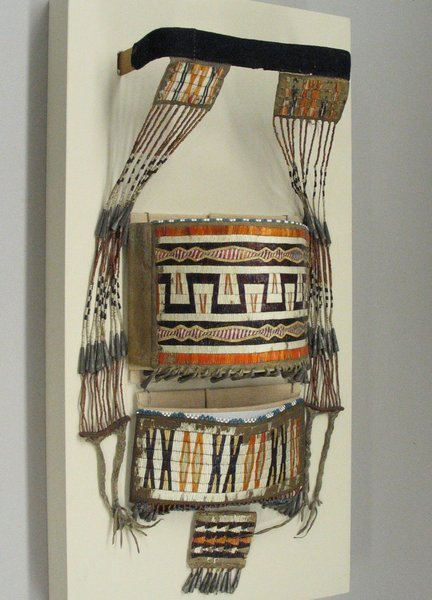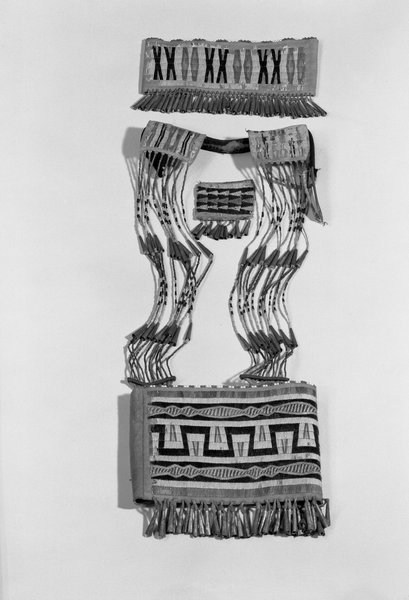Model Cradle Decorations Item Number: 50.67.44 from the Brooklyn Museum



Description
The backboard for the cradle is missing, only the quilled ornaments remain. These consist of two large sections of smoked skin, which wrapped around the cradle and were decorated with orange, white, red, brown, light blue and yellow porcupine quills. The design may be called "otter tail” design as the fretwork moves from left to right as if the otter was doing this: jump-jump-slide-jump-jump. Another suggestion is that he "fret" design may be an abstract thunderbird. There are also two straps decorated with quill wrapped thongs, tin cones, and blue and white pony beads. The cradle model is exceptional in two respects. First it is a model and only 3 are known. (The other being in the NMAI and the Peabody Salem Essex). This suggests it was might have been made for sale as pieces that are missing perhaps were not made, or were lost after it was acquired. The cradle decorations are displayed on this mount condensed, as the piece would have been longer. The rectangular piece below might not be in correct location. B Hail, "Hau, Kola,” pg. 144, fig. 127, shows an early Dakota cradle with three of these rectangular forms dangling down from the bottom of the cradle board not from the wrappings.
Credit Line
Henry L. Batterman Fund and the Frank Sherman Benson Fund
Label
THE JARVIS COLLECTION
The articles in this case and the adjacent clothing case [see 50.67.6] are some of the earliest and finest Eastern Plains pieces in existence. They were collected by Dr. Nathan Sturges Jarvis, a military surgeon stationed at Fort Snelling, Minnesota, between 1833 and 1836. Most items were made by the Eastern and Middle Dakota (Sioux) or by the peoples of the Red River region, including the Red River Métis, Anishinabe, Plains Cree, and Salteaux. Some of the objects were purchased by Jarvis, and others may have been given to him in exchange for his medical services.
By the early nineteenth century, the growing numbers of white settlers and military personnel—following decades of fur trading—had depleted much of the game on which the Dakota and Red River peoples depended. Indigenous ingenuity in combining trade materials such as cloth, metal, and glass beads with traditional hides, pipestone, and porcupine and bird quills is evident in these objects.
Item History
- Made between 1801 and 1836
What
- Name
- Model Cradle Decorations
- Identification Number
- 50.67.44
- Type of Item
- model cradle
- Material
- wood, hide, porcupine, bird quill, tin cone, glass bead and wool cloth
- Measurements
- “No dimensions of cradle as intact available.” ?
Who
- Culture
- Sioux
Where
- Holding Institution
- Brooklyn Museum
When
- Creation Date
- between 1801 and 1836
Other
- Classification
- Model